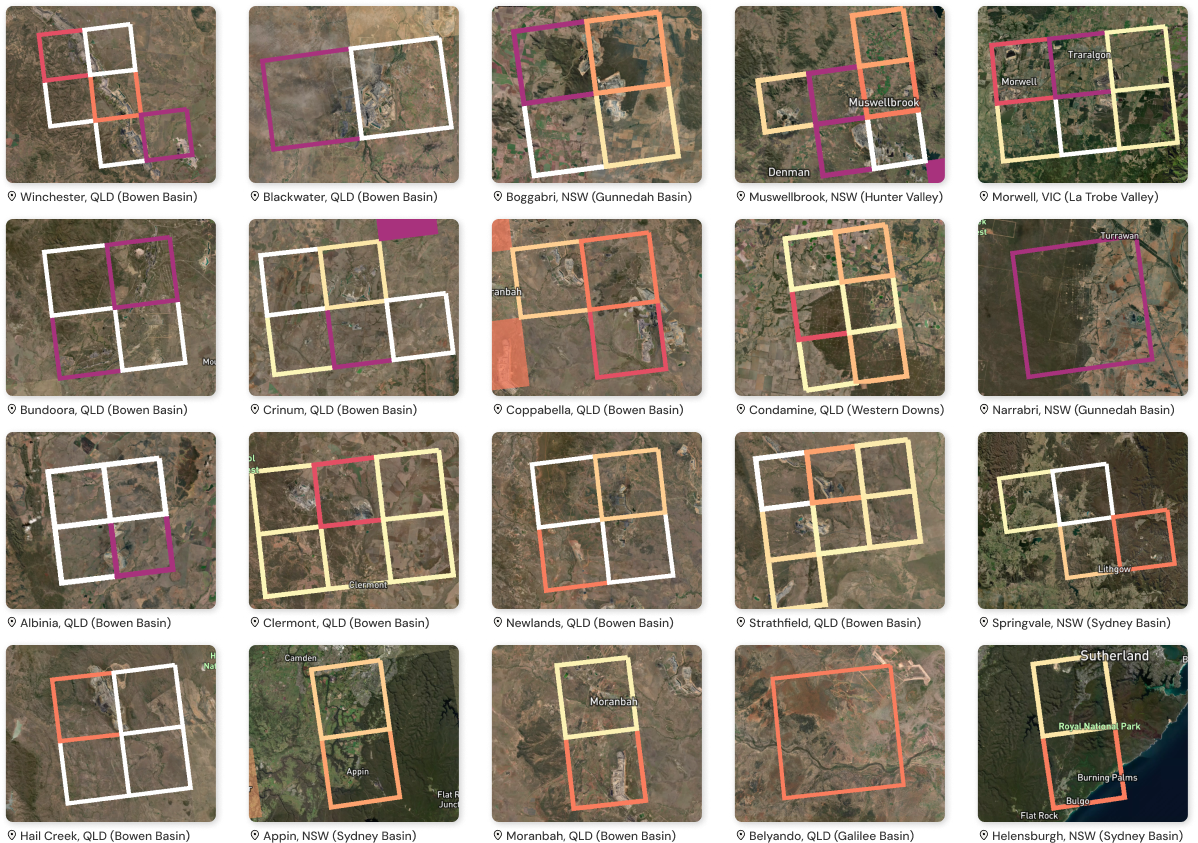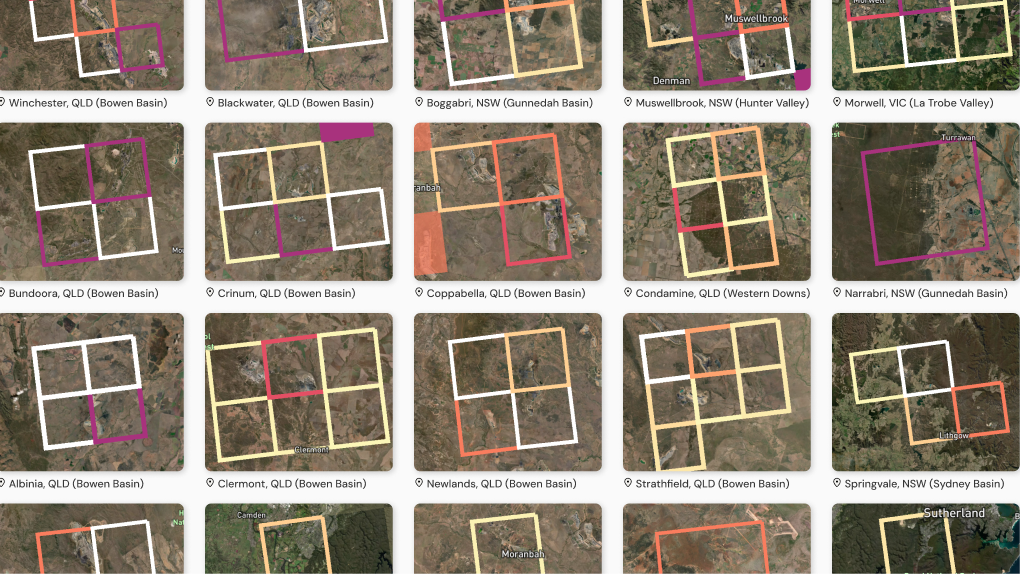The Superpower Institute has released a list of Australia’s twenty methane hotspots, based on observations from Open Methane, a new online tool being launched today that uses satellite technology to measure methane emissions at a 10x10km resolution across Australia. Already in use in comparable countries, satellite technology offers a more accurate and detailed assessment of methane emissions compared to Australia's existing estimation methods.
Currently, Australia’s National Greenhouse and Energy Reporting Scheme (NGERS) relies on self-reported data from major emitters, using emissions factors based on activity levels like the amount of coal mined, or on sparse and nontransparent local measurements. This approach creates significant risk of inaccuracy. Open Methane demonstrates how satellite-based measurements, when combined with ground-based verification, can provide a clearer picture of actual emissions.
Preliminary results from Open Methane estimate that methane emissions may be around double what is currently being reported. These initial results suggest that fossil fuel sites may be significantly underreported under the current NGERS framework. These findings underscore the urgent need for Australia to adopt independent methods in its emissions reporting to ensure more reliable data for its greenhouse gas inventory.
These initial results suggest that fossil fuel sites may be significantly underreported under the current NGERS framework.
TSI is urging that these issues be addressed in the review to be conducted by Australia’s Chief Scientist.
Open Methane is an online platform for monitoring Australia’s methane emissions using a combination of atmospheric modelling and satellite measurements, developed by TSI Chief Scientist and Emeritus Professor Peter Rayner.
The platform is now live, offering public access to continent-scale methane data. Visit www.openmethane.org to explore the data and learn more about Australia’s methane emissions.
Prof Rayner said:
“Methane is a potent greenhouse gas, and understanding where it’s coming from is essential to addressing global warming.
“Of the country’s 20 highest emitting locations, all are sites involving significant coal or gas extraction. This underscores the significant role of the fossil fuel sector in Australia’s methane emissions and highlights where we can make the most impact in reducing them.”
Open Methane results also indicate that emissions from several coal seam gas (CSG) sites may also be higher than previously expected. Three of the 20 highest emitting locations are linked to gas production. Offshore gas sites were excluded from the analysis due to current limitations of satellite observations over water.
Prof Rayner added:
“These findings challenge long-held assumptions about the primary sources of Australia’s methane emissions. While further validation is required, the data suggest that the coal and gas sectors – not agriculture – are the dominant contributors of anthropogenic emissions. This is a crucial finding.
Professor Peter Rayner“These findings challenge long-held assumptions about the primary sources of Australia’s methane emissions."
This underscores the pressing need for Australia to overhaul its greenhouse gas inventory and implement more precise methods for measuring emissions.”
Rod Sims, Chair of TSI, said:
“It’s critical that the upcoming review of emissions reporting, led by Chief Scientist Cathy Foley, takes into account the significant discrepancies of self-reported National Inventory data and ensures that Australia modernises its greenhouse gas reporting with the latest technology. It certainly appears from the Terms of Reference that this will be the case, so our results released today are extremely timely.
“This is not just an academic exercise. Accurate data is the foundation of effective climate policy. If we can’t measure it, we can’t manage it.
“Methane reductions offer the most immediate and impactful way to slow global warming, given its potency and relatively short atmospheric lifetime.
“Addressing fugitive emissions and inaccurate data is the most effective way we can easily bring down methane emissions - it's simply a no-brainer.
“Open Methane helps fill this gap by providing a more precise picture of methane emissions. This clarity is crucial for policymakers, researchers and the public, to make well-informed decisions about Australia’s emission reduction.”

| ‘Sites of concern’: Australia’s top methane-emitting hotspots identified by Open Methane (January–June, 2023) |
|---|
| Winchester, QLD (Bowen Basin) |
| Blackwater, QLD (Bowen Basin) |
| Boggabri, NSW (Gunnedah Basin) |
| Muswellbrook, NSW (Hunter Valley) |
| Morwell, VIC (Latrobe Valley) |
| Bundoora, QLD (Bowen Basin) |
| Crinum, QLD (Bowen Basin) |
| Coppabella, QLD (Bowen Basin) |
| Condamine, QLD (Surat Basin) |
| Narrabri, NSW (Gunnedah Basin) |
| Albinia, QLD (Bowen Basin) |
| Clermont, QLD (Bowen Basin) |
| Newlands, QLD (Bowen Basin) |
| Strathfield, QLD (Bowen Basin) |
| Springvale, NSW (Sydney Basin) |
| Hail Creek, QLD (Bowen Basin) |
| Appin, NSW (Sydney Basin) |
| Moranbah, QLD (Bowen Basin) |
| Belyando, QLD (Galilee Basin) |
| Helensburgh, NSW (Sydney Basin) |
Notes to Editors:
Reported discrepancies in Open Methane results shortly will be compared against an estimate of emissions based on publicly available data, particularly data from Australia’s National Inventory of Greenhouse Gas Emissions. This Inventory is largely based on self-reported data, where facilities either combine an estimate of activity data with standardised emissions factors (which can be outdated or fail to reflect local variations), or rely on sparse and nontransparent local measurements. Both approaches introduce significant uncertainty into the final emissions estimates.
Without external verification, these estimates go unchallenged, raising serious questions about the accuracy of the overall inventory.
Open Methane uses direct satellite measurements, offering a clearer and more precise method for tracking emissions. By incorporating satellite technology and independent verification through ground-based and in-situ measurement, Australia can improve the accuracy of its national inventory and strengthen the integrity of its greenhouse gas reporting.
Shortly we will show Open Methane’s results compared to an “Initial Emissions Estimate” of what could be being reported under NGERS. While we know total fossil fuel emissions being reported there is no public data on the emissions being reported from specific sites or locations. To estimate these, for purposes of high level comparison, Open Methane will use data sources based on publicly available data. While the estimates of emissions from particular sites will be just that, estimates, these will be done within the overall cap provided by NGERS. That is, if the estimate for the NGERS reporting for one site is too low, this means the estimate for another site will be too high.
Background on Open Methane:
Open Methane was developed by The Superpower Institute (TSI) in collaboration with design and innovation company AKQA, with the goal of providing open, accessible, and auditable climate data. The platform uses measurements from the European Space Agency’s Sentinel-5P satellite, which measures methane concentrations in the atmosphere.
By combining satellite measurements with atmospheric modelling, Open Methane identifies discrepancies between the Initial Emissions Estimate and the actual methane observed in the atmosphere. The satellite observations allow for high-resolution measurements, pinpointing emissions down to a 10x10 km grid.
The launch of Open Methane builds on The Superpower Institute’s National Emissions Monitoring Roadmap, which it published in late 2023. The roadmap calls for an integrated national network to monitor methane, CO2 and other greenhouse gases, using a combination of ground-based, in-situ and satellite-based technologies. Establishing this network would allow Australia to regain global leadership in greenhouse gas monitoring, as well as meet the rising demands for accurate emissions data under international agreements.
The Open Methane platform is now live, offering public access to continent-scale methane data. Visit www.openmethane.org to explore the data and learn more about Australia’s methane emissions.

